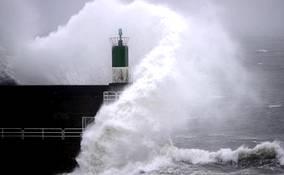Infrastructure protectionStormy weather in Europe's future
Europeis likely to be hit by more violent winter storms in the future; a new study into the effects of climate change has found out why

Atlantic storm Xynthia lashing the French coast // Source: 20minutes.fr
When city planners, utility managers, directors of emergency services, and those in charge of designing and building barriers to secure communities against floods think about the future, they think about the weather. Those who have these responsibilities in Europe should be aware of this: Europe is likely to be hit by more violent winter storms in the future. Now a new study into the effects of climate change has found out why.
A weakening of the warm North Atlantic ocean current, the Meridional Overturning Circulation, during the next century has already been predicted by climate scientists, with suggestions it could lead to colder sea temperatures and reduced warming in Britain.
A University of Reading release reports that new research by scientists at the University of Reading’s Walker Institute and the University of Cologne suggests that the weakening of the warm current could also partially shut down Europe’s protection against violent storms blowing in from the ocean.
The research, published on 1 April in the journal Nature Geoscience, suggests that without such strong warm ocean currents, the regional temperature variations in the North Atlantic will increase.
Such temperature variations, or gradients, help to power storms as they brew up over the ocean. The increase in regional gradients in the Atlantic suggests that the number of storms following a more southerly track, therefore hitting land in Europe, will also increase as greenhouse gas levels rise in the atmosphere.
This is contrary to predictions about changes to storm tracks in other parts of the globe, where increasing temperatures are expected to cause storms to reach higher latitudes than is currently the norm.
The findings are likely to be useful for planners, policy makers and businesses that will need to prepare for the impending changes to our climate in the years ahead.
Dr. Tim Woollings, from the University of Reading’s Department of Meteorology, said: “From the climate models studied, we expect more storms will hit Europe as the 21st century progresses. We found that changes in ocean currents, in response to increasing levels of greenhouse gases, are crucial in shaping the North Atlantic storm track changes.
“Predictions showed obvious changes to expected weather patterns by the end of the century, but it is not yet clear exactly when this signal may first emerge.
“Predicting future changes to storm patterns can be difficult, and we have shown that in order to improve confidence in these predictions we need to improve our observations and models of ocean currents.”
The researchers studied and compared a number of climate models, including those used to help compile the influential fourth assessment report of the Intergovernmental Panel on Climate Change.
— Read more in T. Woollings et al., “Response of the North Atlantic storm track to climate change shaped by ocean–atmosphere coupling,” Nature Geoscience (1 Aoril 2012) (doi:10.1038/ngeo1438)
